Simple Equations: Unit Overview, Assessment, Activities, and Resources
VerifiedAdded on 2023/01/12
|7
|1495
|28
Report
AI Summary
This report offers a comprehensive unit overview focused on teaching simple equations to K12 students. It encompasses the introduction, unit title, stage/year, unit overview, syllabus outcomes, and detailed content on equations. The report outlines worksheet activities, teaching and learning strategies, and assessment activities to evaluate student understanding. It emphasizes the use of ICT integration, including computer graphics and simulations, to enhance learning. The report also provides a list of resources, including textbooks, diagrams, and online materials, to support teaching. Finally, it includes an assessment overview that details the metrics used to measure student comprehension and their ability to solve equations, along with a list of relevant references from books and journals.
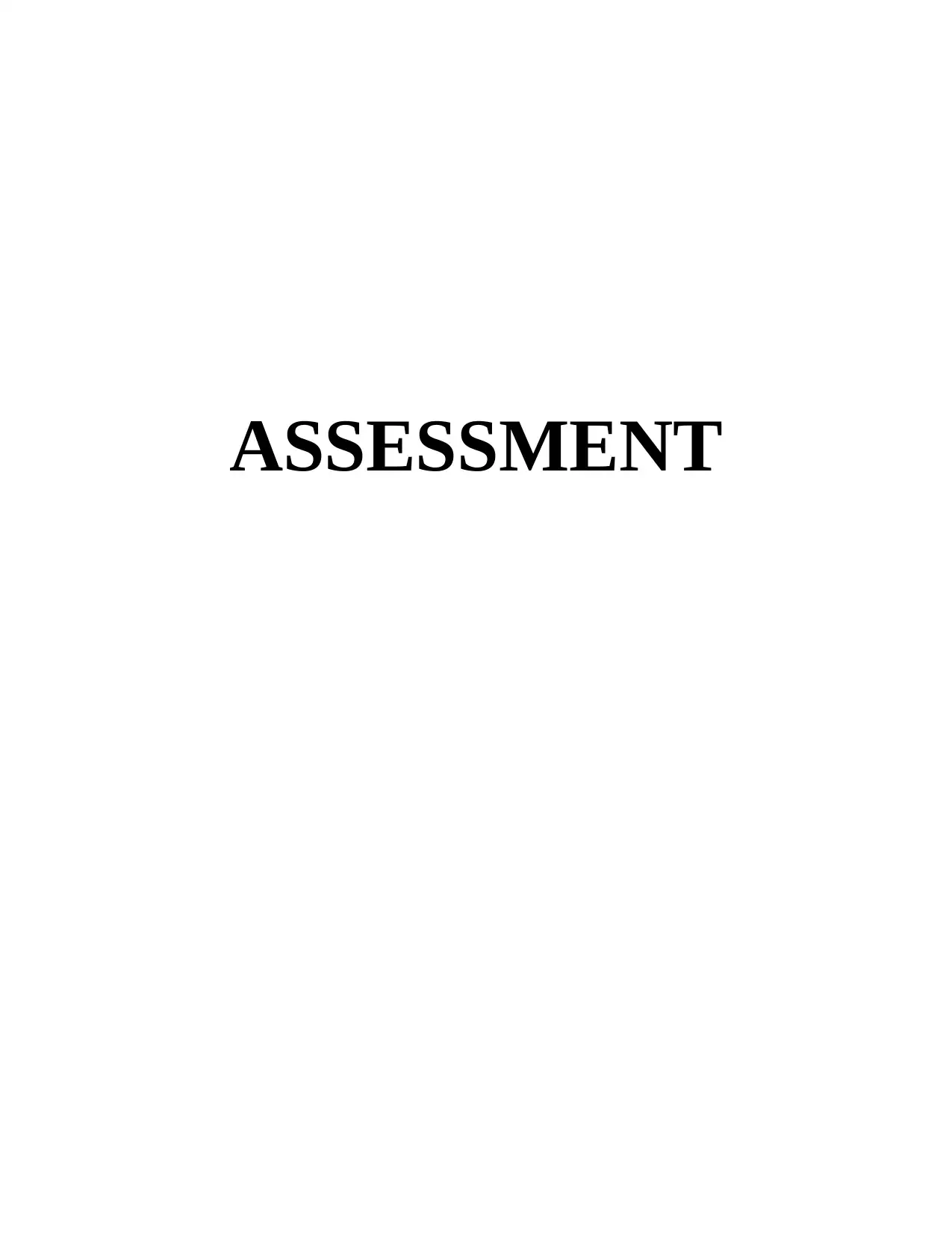
ASSESSMENT
Paraphrase This Document
Need a fresh take? Get an instant paraphrase of this document with our AI Paraphraser
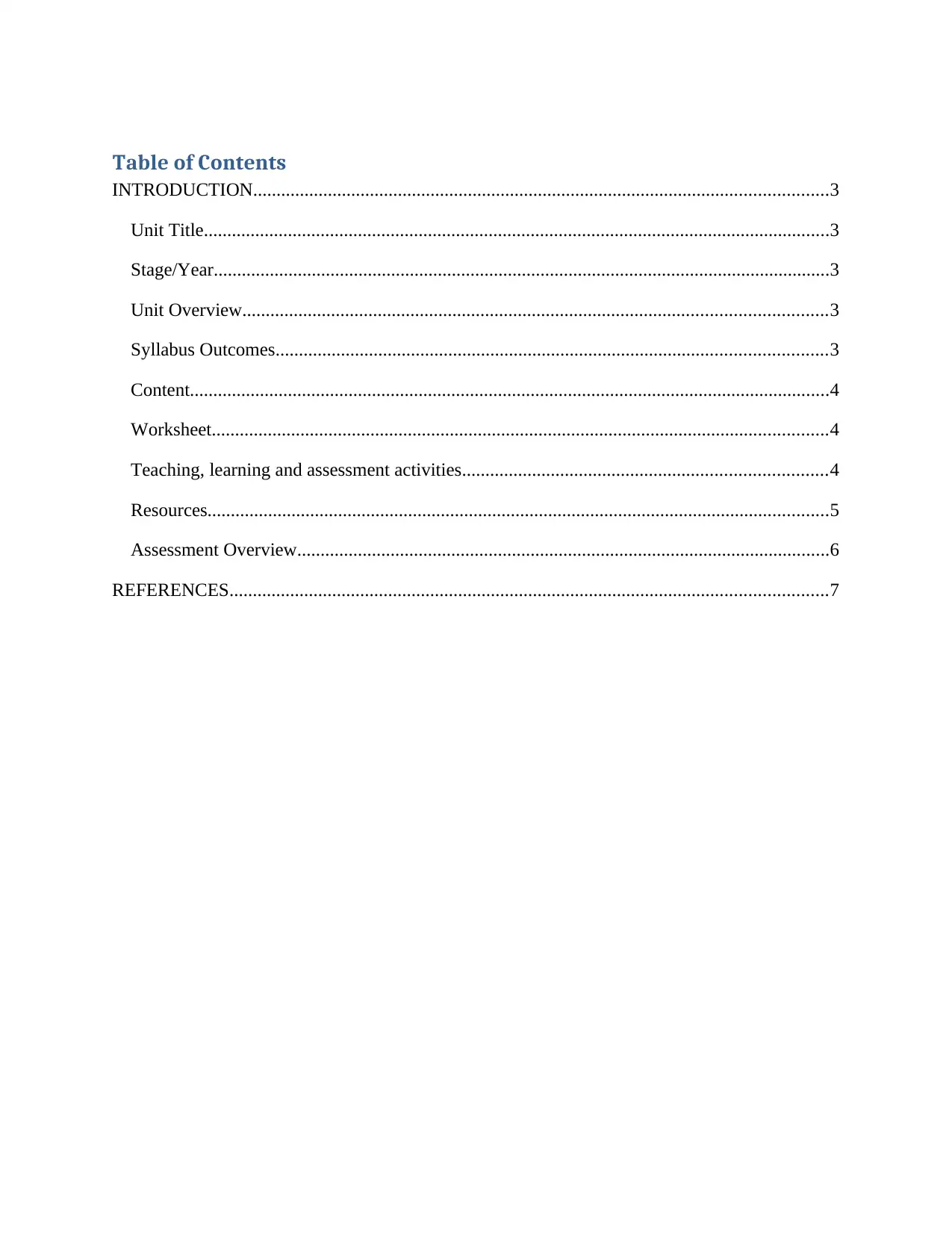
Table of Contents
INTRODUCTION...........................................................................................................................3
Unit Title......................................................................................................................................3
Stage/Year....................................................................................................................................3
Unit Overview.............................................................................................................................3
Syllabus Outcomes......................................................................................................................3
Content.........................................................................................................................................4
Worksheet....................................................................................................................................4
Teaching, learning and assessment activities..............................................................................4
Resources.....................................................................................................................................5
Assessment Overview..................................................................................................................6
REFERENCES................................................................................................................................7
INTRODUCTION...........................................................................................................................3
Unit Title......................................................................................................................................3
Stage/Year....................................................................................................................................3
Unit Overview.............................................................................................................................3
Syllabus Outcomes......................................................................................................................3
Content.........................................................................................................................................4
Worksheet....................................................................................................................................4
Teaching, learning and assessment activities..............................................................................4
Resources.....................................................................................................................................5
Assessment Overview..................................................................................................................6
REFERENCES................................................................................................................................7
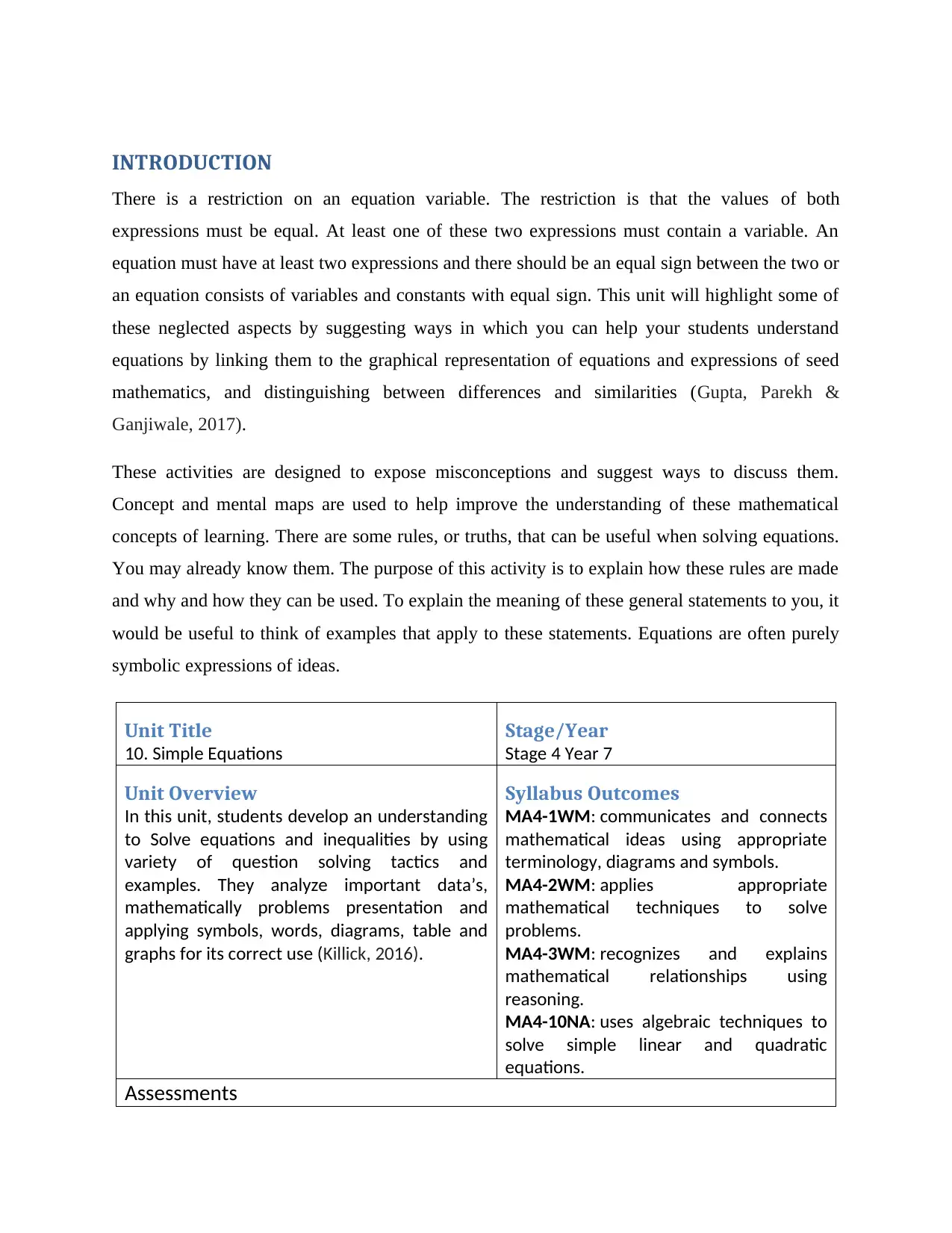
INTRODUCTION
There is a restriction on an equation variable. The restriction is that the values of both
expressions must be equal. At least one of these two expressions must contain a variable. An
equation must have at least two expressions and there should be an equal sign between the two or
an equation consists of variables and constants with equal sign. This unit will highlight some of
these neglected aspects by suggesting ways in which you can help your students understand
equations by linking them to the graphical representation of equations and expressions of seed
mathematics, and distinguishing between differences and similarities (Gupta, Parekh &
Ganjiwale, 2017).
These activities are designed to expose misconceptions and suggest ways to discuss them.
Concept and mental maps are used to help improve the understanding of these mathematical
concepts of learning. There are some rules, or truths, that can be useful when solving equations.
You may already know them. The purpose of this activity is to explain how these rules are made
and why and how they can be used. To explain the meaning of these general statements to you, it
would be useful to think of examples that apply to these statements. Equations are often purely
symbolic expressions of ideas.
Unit Title
10. Simple Equations
Stage/Year
Stage 4 Year 7
Unit Overview
In this unit, students develop an understanding
to Solve equations and inequalities by using
variety of question solving tactics and
examples. They analyze important data’s,
mathematically problems presentation and
applying symbols, words, diagrams, table and
graphs for its correct use (Killick, 2016).
Syllabus Outcomes
MA4-1WM: communicates and connects
mathematical ideas using appropriate
terminology, diagrams and symbols.
MA4-2WM: applies appropriate
mathematical techniques to solve
problems.
MA4-3WM: recognizes and explains
mathematical relationships using
reasoning.
MA4-10NA: uses algebraic techniques to
solve simple linear and quadratic
equations.
Assessments
There is a restriction on an equation variable. The restriction is that the values of both
expressions must be equal. At least one of these two expressions must contain a variable. An
equation must have at least two expressions and there should be an equal sign between the two or
an equation consists of variables and constants with equal sign. This unit will highlight some of
these neglected aspects by suggesting ways in which you can help your students understand
equations by linking them to the graphical representation of equations and expressions of seed
mathematics, and distinguishing between differences and similarities (Gupta, Parekh &
Ganjiwale, 2017).
These activities are designed to expose misconceptions and suggest ways to discuss them.
Concept and mental maps are used to help improve the understanding of these mathematical
concepts of learning. There are some rules, or truths, that can be useful when solving equations.
You may already know them. The purpose of this activity is to explain how these rules are made
and why and how they can be used. To explain the meaning of these general statements to you, it
would be useful to think of examples that apply to these statements. Equations are often purely
symbolic expressions of ideas.
Unit Title
10. Simple Equations
Stage/Year
Stage 4 Year 7
Unit Overview
In this unit, students develop an understanding
to Solve equations and inequalities by using
variety of question solving tactics and
examples. They analyze important data’s,
mathematically problems presentation and
applying symbols, words, diagrams, table and
graphs for its correct use (Killick, 2016).
Syllabus Outcomes
MA4-1WM: communicates and connects
mathematical ideas using appropriate
terminology, diagrams and symbols.
MA4-2WM: applies appropriate
mathematical techniques to solve
problems.
MA4-3WM: recognizes and explains
mathematical relationships using
reasoning.
MA4-10NA: uses algebraic techniques to
solve simple linear and quadratic
equations.
Assessments
⊘ This is a preview!⊘
Do you want full access?
Subscribe today to unlock all pages.

Trusted by 1+ million students worldwide
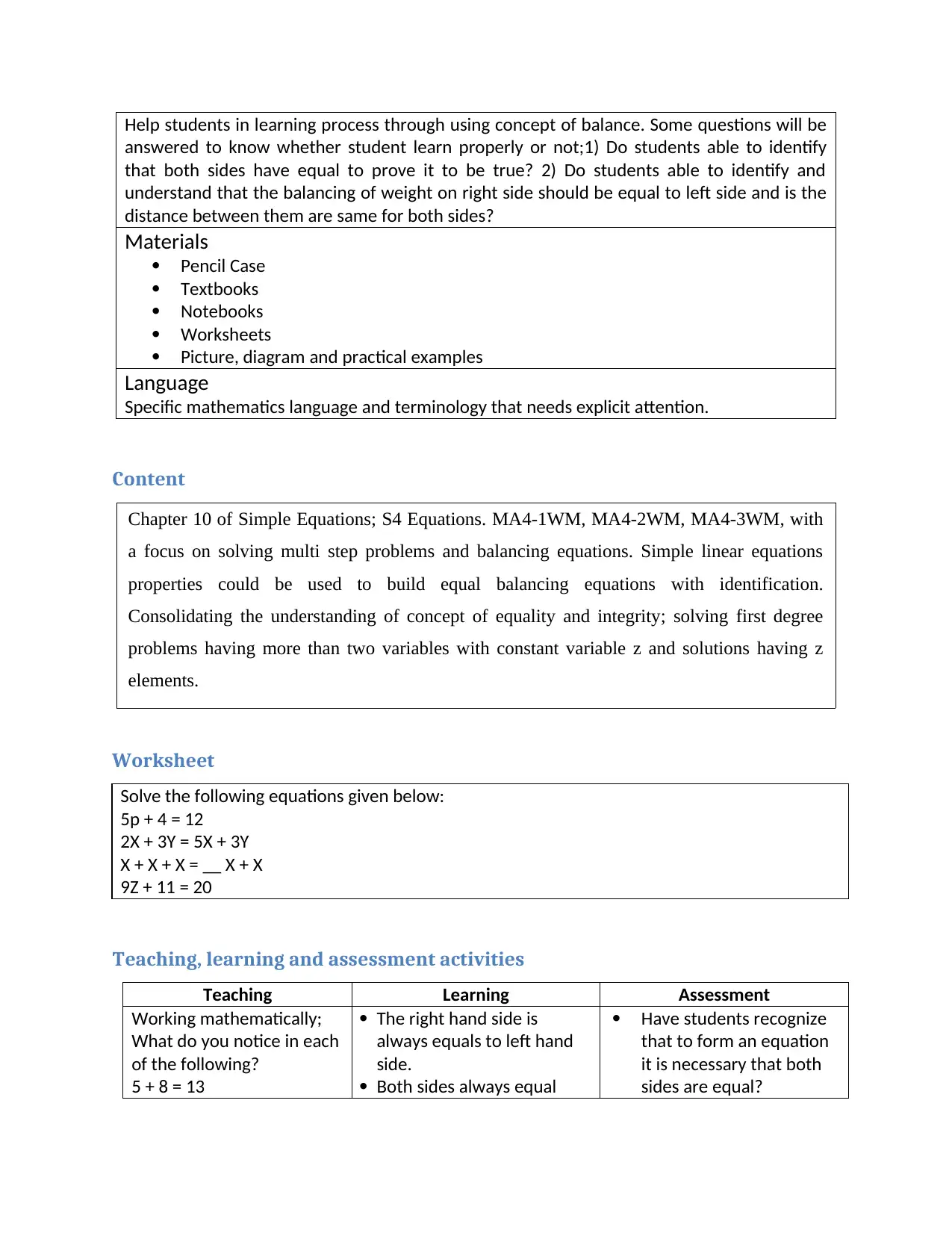
Help students in learning process through using concept of balance. Some questions will be
answered to know whether student learn properly or not;1) Do students able to identify
that both sides have equal to prove it to be true? 2) Do students able to identify and
understand that the balancing of weight on right side should be equal to left side and is the
distance between them are same for both sides?
Materials
Pencil Case
Textbooks
Notebooks
Worksheets
Picture, diagram and practical examples
Language
Specific mathematics language and terminology that needs explicit attention.
Content
Worksheet
Solve the following equations given below:
5p + 4 = 12
2X + 3Y = 5X + 3Y
X + X + X = __ X + X
9Z + 11 = 20
Teaching, learning and assessment activities
Teaching Learning Assessment
Working mathematically;
What do you notice in each
of the following?
5 + 8 = 13
The right hand side is
always equals to left hand
side.
Both sides always equal
Have students recognize
that to form an equation
it is necessary that both
sides are equal?
Chapter 10 of Simple Equations; S4 Equations. MA4-1WM, MA4-2WM, MA4-3WM, with
a focus on solving multi step problems and balancing equations. Simple linear equations
properties could be used to build equal balancing equations with identification.
Consolidating the understanding of concept of equality and integrity; solving first degree
problems having more than two variables with constant variable z and solutions having z
elements.
answered to know whether student learn properly or not;1) Do students able to identify
that both sides have equal to prove it to be true? 2) Do students able to identify and
understand that the balancing of weight on right side should be equal to left side and is the
distance between them are same for both sides?
Materials
Pencil Case
Textbooks
Notebooks
Worksheets
Picture, diagram and practical examples
Language
Specific mathematics language and terminology that needs explicit attention.
Content
Worksheet
Solve the following equations given below:
5p + 4 = 12
2X + 3Y = 5X + 3Y
X + X + X = __ X + X
9Z + 11 = 20
Teaching, learning and assessment activities
Teaching Learning Assessment
Working mathematically;
What do you notice in each
of the following?
5 + 8 = 13
The right hand side is
always equals to left hand
side.
Both sides always equal
Have students recognize
that to form an equation
it is necessary that both
sides are equal?
Chapter 10 of Simple Equations; S4 Equations. MA4-1WM, MA4-2WM, MA4-3WM, with
a focus on solving multi step problems and balancing equations. Simple linear equations
properties could be used to build equal balancing equations with identification.
Consolidating the understanding of concept of equality and integrity; solving first degree
problems having more than two variables with constant variable z and solutions having z
elements.
Paraphrase This Document
Need a fresh take? Get an instant paraphrase of this document with our AI Paraphraser
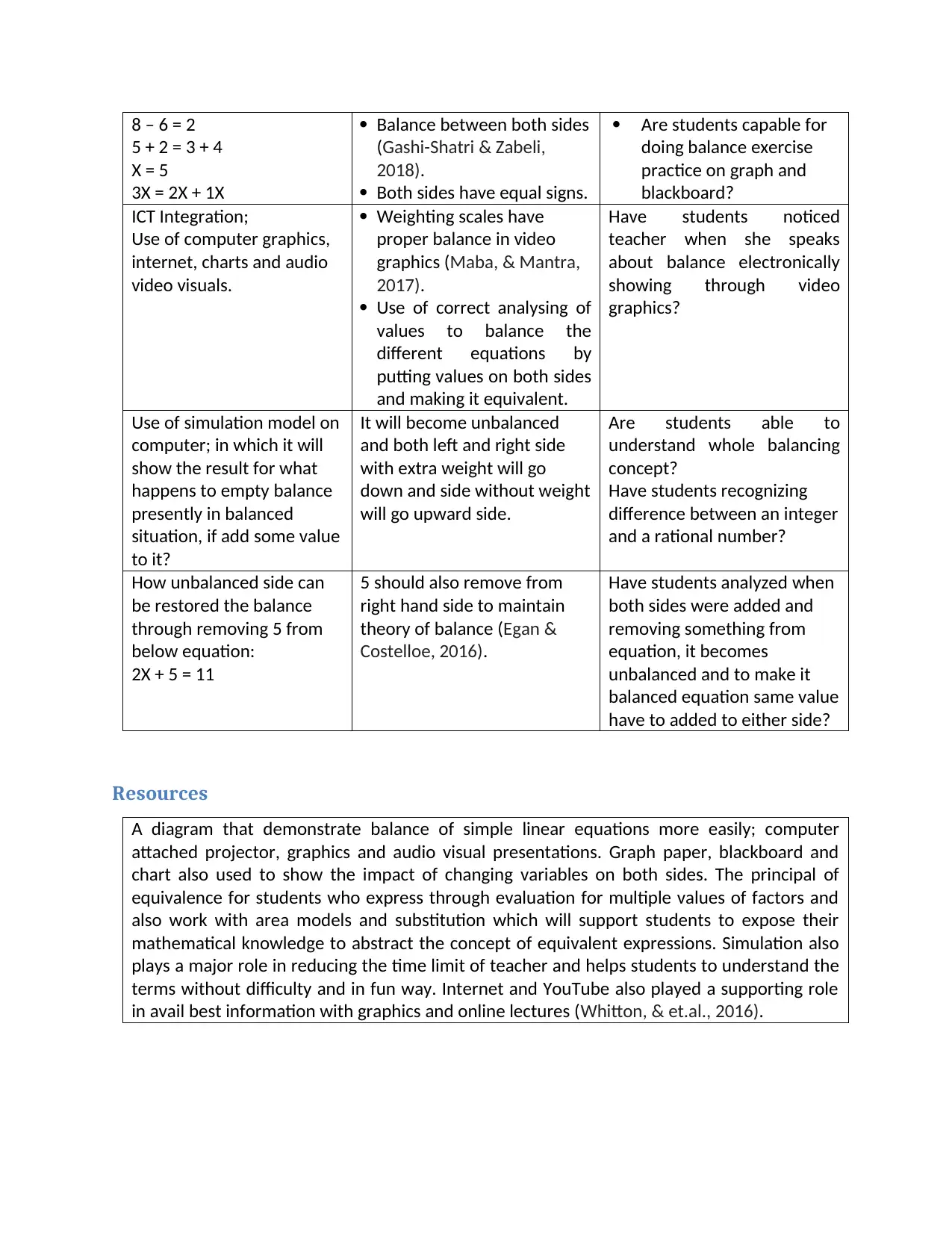
8 – 6 = 2
5 + 2 = 3 + 4
X = 5
3X = 2X + 1X
Balance between both sides
(Gashi-Shatri & Zabeli,
2018).
Both sides have equal signs.
Are students capable for
doing balance exercise
practice on graph and
blackboard?
ICT Integration;
Use of computer graphics,
internet, charts and audio
video visuals.
Weighting scales have
proper balance in video
graphics (Maba, & Mantra,
2017).
Use of correct analysing of
values to balance the
different equations by
putting values on both sides
and making it equivalent.
Have students noticed
teacher when she speaks
about balance electronically
showing through video
graphics?
Use of simulation model on
computer; in which it will
show the result for what
happens to empty balance
presently in balanced
situation, if add some value
to it?
It will become unbalanced
and both left and right side
with extra weight will go
down and side without weight
will go upward side.
Are students able to
understand whole balancing
concept?
Have students recognizing
difference between an integer
and a rational number?
How unbalanced side can
be restored the balance
through removing 5 from
below equation:
2X + 5 = 11
5 should also remove from
right hand side to maintain
theory of balance (Egan &
Costelloe, 2016).
Have students analyzed when
both sides were added and
removing something from
equation, it becomes
unbalanced and to make it
balanced equation same value
have to added to either side?
Resources
A diagram that demonstrate balance of simple linear equations more easily; computer
attached projector, graphics and audio visual presentations. Graph paper, blackboard and
chart also used to show the impact of changing variables on both sides. The principal of
equivalence for students who express through evaluation for multiple values of factors and
also work with area models and substitution which will support students to expose their
mathematical knowledge to abstract the concept of equivalent expressions. Simulation also
plays a major role in reducing the time limit of teacher and helps students to understand the
terms without difficulty and in fun way. Internet and YouTube also played a supporting role
in avail best information with graphics and online lectures (Whitton, & et.al., 2016).
5 + 2 = 3 + 4
X = 5
3X = 2X + 1X
Balance between both sides
(Gashi-Shatri & Zabeli,
2018).
Both sides have equal signs.
Are students capable for
doing balance exercise
practice on graph and
blackboard?
ICT Integration;
Use of computer graphics,
internet, charts and audio
video visuals.
Weighting scales have
proper balance in video
graphics (Maba, & Mantra,
2017).
Use of correct analysing of
values to balance the
different equations by
putting values on both sides
and making it equivalent.
Have students noticed
teacher when she speaks
about balance electronically
showing through video
graphics?
Use of simulation model on
computer; in which it will
show the result for what
happens to empty balance
presently in balanced
situation, if add some value
to it?
It will become unbalanced
and both left and right side
with extra weight will go
down and side without weight
will go upward side.
Are students able to
understand whole balancing
concept?
Have students recognizing
difference between an integer
and a rational number?
How unbalanced side can
be restored the balance
through removing 5 from
below equation:
2X + 5 = 11
5 should also remove from
right hand side to maintain
theory of balance (Egan &
Costelloe, 2016).
Have students analyzed when
both sides were added and
removing something from
equation, it becomes
unbalanced and to make it
balanced equation same value
have to added to either side?
Resources
A diagram that demonstrate balance of simple linear equations more easily; computer
attached projector, graphics and audio visual presentations. Graph paper, blackboard and
chart also used to show the impact of changing variables on both sides. The principal of
equivalence for students who express through evaluation for multiple values of factors and
also work with area models and substitution which will support students to expose their
mathematical knowledge to abstract the concept of equivalent expressions. Simulation also
plays a major role in reducing the time limit of teacher and helps students to understand the
terms without difficulty and in fun way. Internet and YouTube also played a supporting role
in avail best information with graphics and online lectures (Whitton, & et.al., 2016).
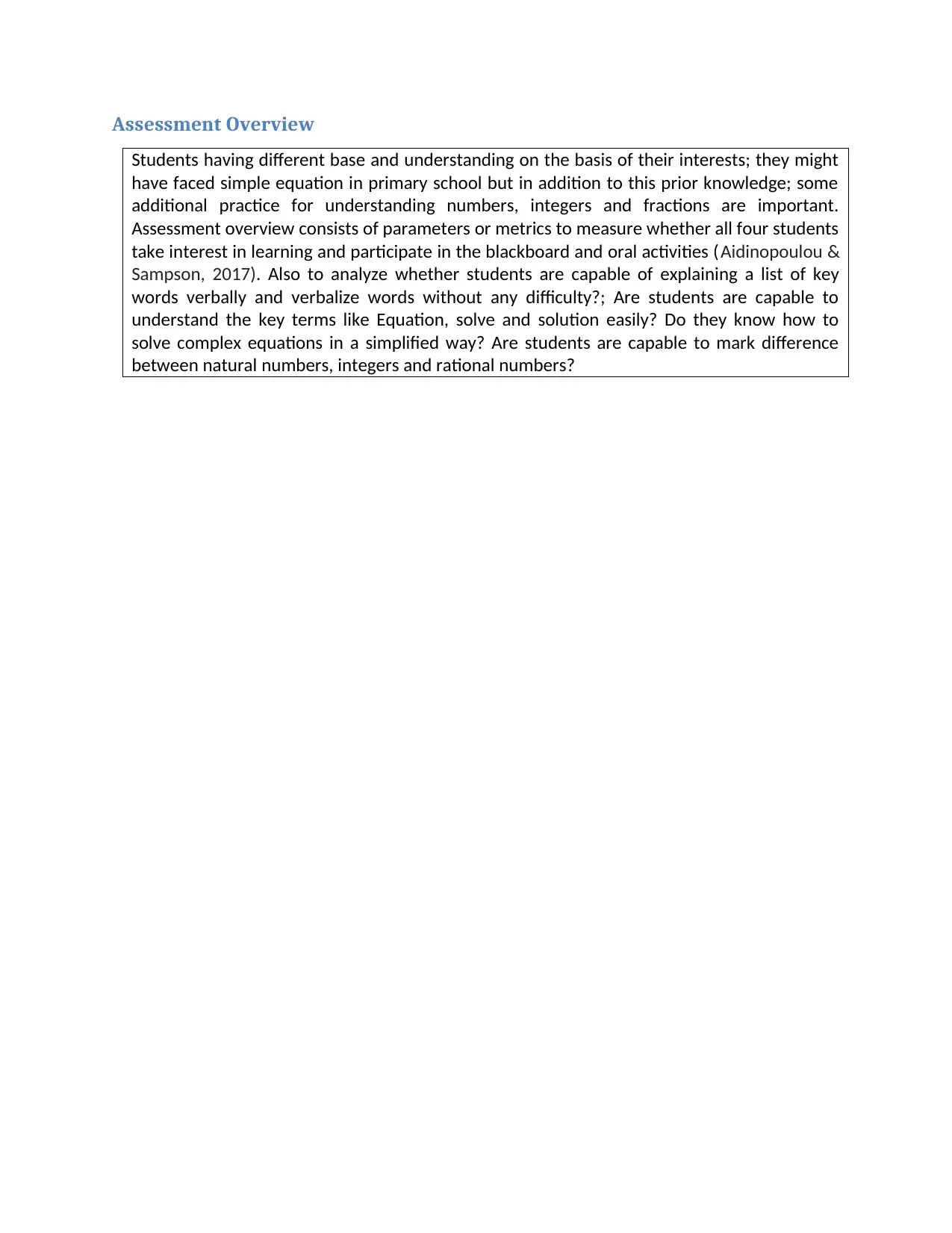
Assessment Overview
Students having different base and understanding on the basis of their interests; they might
have faced simple equation in primary school but in addition to this prior knowledge; some
additional practice for understanding numbers, integers and fractions are important.
Assessment overview consists of parameters or metrics to measure whether all four students
take interest in learning and participate in the blackboard and oral activities (Aidinopoulou &
Sampson, 2017). Also to analyze whether students are capable of explaining a list of key
words verbally and verbalize words without any difficulty?; Are students are capable to
understand the key terms like Equation, solve and solution easily? Do they know how to
solve complex equations in a simplified way? Are students are capable to mark difference
between natural numbers, integers and rational numbers?
Students having different base and understanding on the basis of their interests; they might
have faced simple equation in primary school but in addition to this prior knowledge; some
additional practice for understanding numbers, integers and fractions are important.
Assessment overview consists of parameters or metrics to measure whether all four students
take interest in learning and participate in the blackboard and oral activities (Aidinopoulou &
Sampson, 2017). Also to analyze whether students are capable of explaining a list of key
words verbally and verbalize words without any difficulty?; Are students are capable to
understand the key terms like Equation, solve and solution easily? Do they know how to
solve complex equations in a simplified way? Are students are capable to mark difference
between natural numbers, integers and rational numbers?
⊘ This is a preview!⊘
Do you want full access?
Subscribe today to unlock all pages.

Trusted by 1+ million students worldwide
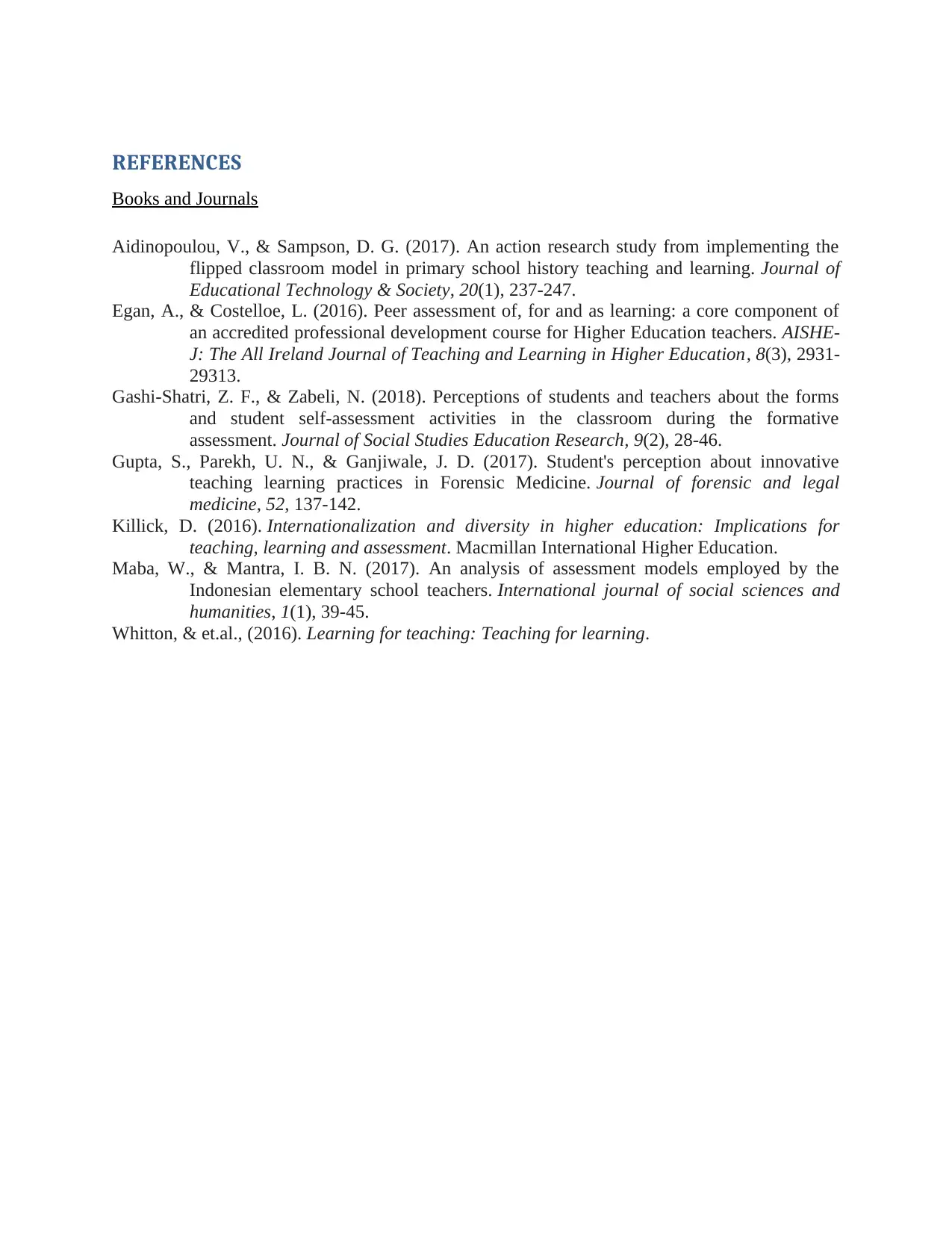
REFERENCES
Books and Journals
Aidinopoulou, V., & Sampson, D. G. (2017). An action research study from implementing the
flipped classroom model in primary school history teaching and learning. Journal of
Educational Technology & Society, 20(1), 237-247.
Egan, A., & Costelloe, L. (2016). Peer assessment of, for and as learning: a core component of
an accredited professional development course for Higher Education teachers. AISHE-
J: The All Ireland Journal of Teaching and Learning in Higher Education, 8(3), 2931-
29313.
Gashi-Shatri, Z. F., & Zabeli, N. (2018). Perceptions of students and teachers about the forms
and student self-assessment activities in the classroom during the formative
assessment. Journal of Social Studies Education Research, 9(2), 28-46.
Gupta, S., Parekh, U. N., & Ganjiwale, J. D. (2017). Student's perception about innovative
teaching learning practices in Forensic Medicine. Journal of forensic and legal
medicine, 52, 137-142.
Killick, D. (2016). Internationalization and diversity in higher education: Implications for
teaching, learning and assessment. Macmillan International Higher Education.
Maba, W., & Mantra, I. B. N. (2017). An analysis of assessment models employed by the
Indonesian elementary school teachers. International journal of social sciences and
humanities, 1(1), 39-45.
Whitton, & et.al., (2016). Learning for teaching: Teaching for learning.
Books and Journals
Aidinopoulou, V., & Sampson, D. G. (2017). An action research study from implementing the
flipped classroom model in primary school history teaching and learning. Journal of
Educational Technology & Society, 20(1), 237-247.
Egan, A., & Costelloe, L. (2016). Peer assessment of, for and as learning: a core component of
an accredited professional development course for Higher Education teachers. AISHE-
J: The All Ireland Journal of Teaching and Learning in Higher Education, 8(3), 2931-
29313.
Gashi-Shatri, Z. F., & Zabeli, N. (2018). Perceptions of students and teachers about the forms
and student self-assessment activities in the classroom during the formative
assessment. Journal of Social Studies Education Research, 9(2), 28-46.
Gupta, S., Parekh, U. N., & Ganjiwale, J. D. (2017). Student's perception about innovative
teaching learning practices in Forensic Medicine. Journal of forensic and legal
medicine, 52, 137-142.
Killick, D. (2016). Internationalization and diversity in higher education: Implications for
teaching, learning and assessment. Macmillan International Higher Education.
Maba, W., & Mantra, I. B. N. (2017). An analysis of assessment models employed by the
Indonesian elementary school teachers. International journal of social sciences and
humanities, 1(1), 39-45.
Whitton, & et.al., (2016). Learning for teaching: Teaching for learning.
1 out of 7
Related Documents
Your All-in-One AI-Powered Toolkit for Academic Success.
+13062052269
info@desklib.com
Available 24*7 on WhatsApp / Email
![[object Object]](/_next/static/media/star-bottom.7253800d.svg)
Unlock your academic potential
Copyright © 2020–2025 A2Z Services. All Rights Reserved. Developed and managed by ZUCOL.





